Paper Menu >>
Journal Menu >>
 J. Software Engineer & Applications, 2010, 3: 191-197 doi:10.4236/jsea.2010.33024 Published Online March 2010 (http://www.SciRP.org/journal/jsea) Copyright © 2010 SciRes. JSEA 191 Linear Control Problems of the Fuzzy Maps Andrej V. Plotnikov, Tatyana A. Komleva, Irina V. Molchanyuk Department of Applied Mathematics, Odessa State Academy of Civil Engineering and Architecture, Odessa, Ukraine. Email: a-plotnikov@ukr.net, t-komleva@ukr.net, i-molchanuyk@ukr.net Received October 28th, 2009; revised November 16th, 2009; accepted November 20th, 2009. ABSTRACT In the present paper, we show the some properties of the fuzzy R-solution of the control linear fuzzy differential inclu- sions and research the optimal time problems for it. Keywords: Fuzzy Differential Inclusions, Control Problems 1. Introduction The first study of differential equations with multivalued right-hand sides was performed by A. Marchaud [1] and S. C. Zaremba [2]. In early sixties, T. Wazewski [3,4], A. F. Filippov [5] obtained fundamental results on existence and properties of the differential equations with multi- valued right-hand sides (differential inclusions). One of the most important results of these articles was an estab- lishment of the relation between differential inclusions and optimal control problems, that promoted to develop the differential inclusion theory [6–9]. Considering of the differential inclusions required to study properties of multivalued functions, i.e. an elab- oration the whole tool of mathematical analysis for mul- tivalued functions [6,10,11]. In works [12,13] annotate of an R-solution for differ- ential inclusion is introduced as an absolutely continuous multivalued function. Various problems for the R-solu- tion theory were regarded in [14–18]. The basic idea for a development of an equation for R-solutions (integral funnels) is contained in [19]. In the last years there has been forming new approach to control problems of dynamic systems, which founda- tion on analysis of trajectory bundle but not separate tra- jectories. The section of this bundle in any instant is some set and it is necessary to describe the evolution of this set. Obtaining and research dynamic equations of sets there is important problem in this case. The metric space of sets with the Hausdorff metric is natural space for description dynamic of sets. In theory of multivalued maps definitions on derivative as for single-valued maps is impossible because space of sets is nonlinear. This bound possibility description dynamic sets by differential equations. Therefore, the control differential equations with set of initial conditions [20–22] and the control differen- tial inclusions [8,23–34] use for it. In recent years, the fuzzy set theory introduced by Zadeh [35] has emerged as an interesting and fascinating branch of pure and applied sciences. The applications of fuzzy set theory can be found in many branches of re- gional, physical, mathematical, differential equations, and engineering sciences. Recently there have been new advances in the theory of fuzzy differential equations [36–47] and inclusions [43,48–52] as well as in the the- ory of control fuzzy differential equations [53–55] and inclusions [56,57]. In this article we consider the some properties of the fuzzy R-solution of the control linear fuzzy differential inclusions and research the optimal time problems for it. 2. The Fundamental Definitions and Designations Let nn RconvRcomp be a set of all nonempty (con- vex) compact subsets from the space Rn, ABSBASBAh rr r )(,)(min,0 be Hausdorff distance between sets A and B, Sr(A) is r -neighborhood of set A. Let En be the set of all u: Rn→[0,1] such that u satisfies the following conditions: 1) u is normal, that is, there exists an such that u(x0)=1; n Rx 0 2) u is fuzzy convex, that is, )(),(min)1( yuxuyxu ; 3) For any and n Ryx,10 ; 4) u is upper semicontinuous; 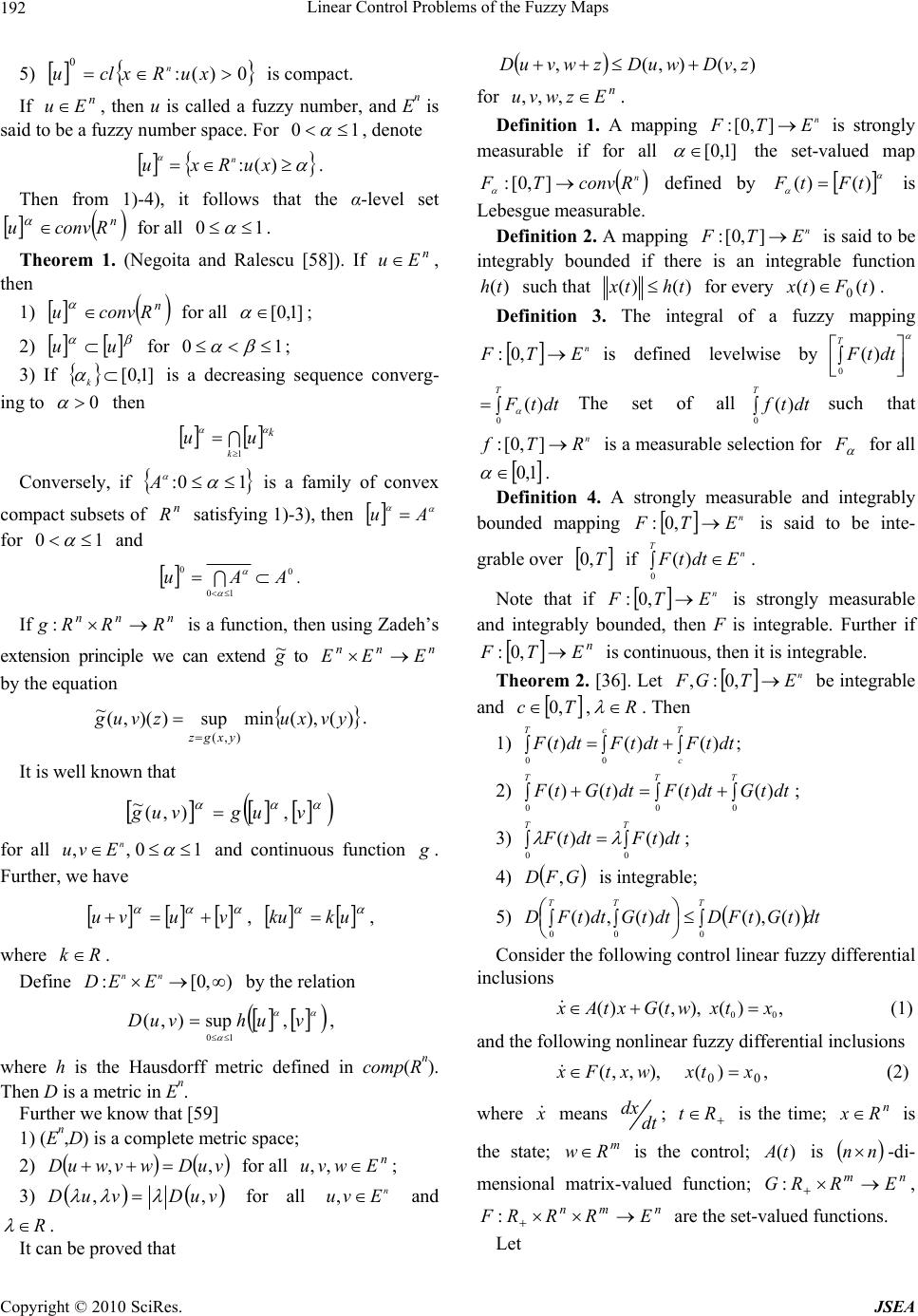 Linear Control Problems of the Fuzzy Maps 192 5) is compact. 0)(: 0 xuRxclu n If , then u is called a fuzzy number, and En is said to be a fuzzy number space. For n Eu 10 , denote )(: xuRxu n. Then from 1)-4), it follows that the α-level set for all n Rconvu 10 . Theorem 1. (Negoita and Ralescu [58]). If , then n Eu 1) for all n Rconvu ]1,0[ ; 2) for uu 10 ; 3) If ]1,0[ k is a decreasing sequence converg- ing to 0 then 1 k k uu Conversely, if is a family of convex compact subsets of satisfying 1)-3), then 10: A n R Au for 10 and 0 10 0AAu . If is a function, then using Zadeh’s extension principle we can extend g nnnRRRg : ~ to by the equation nnn EEE )(),(minsup))(,( ~ ),( yvxuzvug yxgz . It is well known that vugvug ,),( ~ for all and continuous function 10,, n Evu g . Further, we have vuvu , , ukku where . Rk Define by the relation ),0[: nn EED vuhvuD ,sup),( 10 , where h is the Hausdorff metric defined in comp(Rn). Then D is a metric in En. Further we know that [59] 1) (En,D) is a complete metric space; 2) for all ; vuDwvwuD ,, n Ewvu,, 3) vuDvuD ,, for all and n Evu , R . It can be proved that ),(),(, zvDwuDzwvuD for . n Ezwvu ,,, Definition 1. A mapping is strongly measurable if for all n ETF ],0[: ]1,0[ the set-valued map n RconvTF ],0[: defined by )(tF )(tF is Lebesgue measurable. Definition 2. A mapping is said to be integrably bounded if there is an integrable function such that n ETF ],0[: )(th )()( thtx for every . )( 0tF)(tx Definition 3. The integral of a fuzzy mapping n ETF ,0: T dttF 0 )( n RTf ],0[: is defined levelwise by The set of allsuch that is a measurable selection for for all T dttF 0 )( F T dttf 0 )( 1,0 . Definition 4. A strongly measurable and integrably bounded mapping n ETF ,0: is said to be inte- grable over T,0 if . Tn EdttF 0 )( Note that if n ETF ,0: is strongly measurable and integrably bounded, then F is integrable. Further if n ETF ,0: is continuous, then it is integrable. Theorem 2. [36]. Let be integrable and n ETGF,0:, Tc ,0 ,R . Then 1) TT c c dttFdttFdttF 00 ;)()()( 2) ; TTT dttGdttFdttGtF 000 )()()()( 3) ; TT dttFdttF 00 )()( 4) GFD , is integrable; 5) dttGtFDdttGdttFD TTT 000 )(),()(,)( Consider the following control linear fuzzy differential inclusions ,)(),,()( 00xtxwtGxtAx (1) and the following nonlinear fuzzy differential inclusions ,)(),,,(00 xtxwxtFx (2) where means x dt dx ; Rt is the time; is the state; is the control; is n Rx m Rw )(tA nn -di- mensional matrix-valued function; , are the set-valued functions. n mER RG : n ERF :mn RR Let Copyright © 2010 SciRes. JSEA 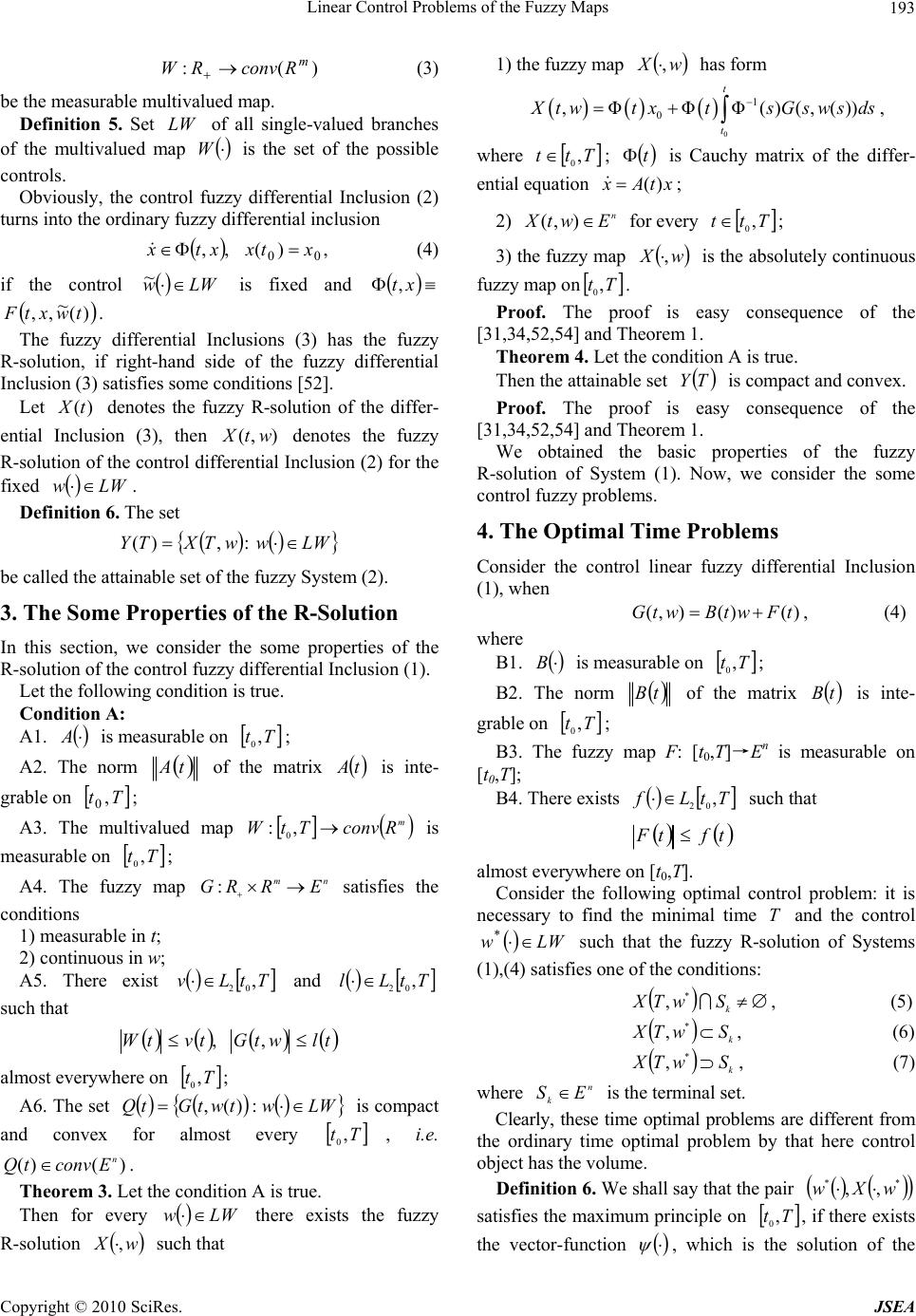 Linear Control Problems of the Fuzzy Maps193 )(: m RconvRW (3) be the measurable multivalued map. Definition 5. Set of all single-valued branches of the multivalued map is the set of the possible controls. LW W Obviously, the control fuzzy differential Inclusion (2) turns into the ordinary fuzzy differential inclusion ,)(,, 00 xtxxtx (4) if the control LWw ~ is fixed and xt, )( ~ ,, twxtF . The fuzzy differential Inclusions (3) has the fuzzy R-solution, if right-hand side of the fuzzy differential Inclusion (3) satisfies some conditions [52]. Let denotes the fuzzy R-solution of the differ- ential Inclusion (3), then denotes the fuzzy R-solution of the control differential Inclusion (2) for the fixed . )(tX w ),(wtX LW Definition 6. The set LWwwTXTY :,)( be called the attainable set of the fuzzy System (2). 3. The Some Properties of the R-Solution In this section, we consider the some properties of the R-solution of the control fuzzy differential Inclusion (1). Let the following condition is true. Condition A: A1. is measurable on A Tt , 0; A2. The norm tA of the matrix is inte- grable on ; tA Tt , 0 A3. The multivalued map m RconvTtW,: 0 is measurable on ; Tt, 0 A4. The fuzzy map satisfies the conditions nm ERRG : 1) measurable in t; 2) continuous in w; A5. There exist TtLv , 02 and TtLl , 02 such that tlwtGtvtW ,, almost everywhere on ; Tt , 0 A6. The set is compact and convex for almost every , i.e. . LWwtwtGtQ :)(, t, 0 ) n T ()( EconvtQ Theorem 3. Let the condition A is true. Then for every there exists the fuzzy R-solution such that LWw wX , 1) the fuzzy map wX , has form 0 1 0 ,ΦΦΦ() (, ()) t t X twt xtsGswsds , where Ttt , 0 ; t is Cauchy matrix of the differ- ential equation xtA )(x ; 2) for every ; n EwtX ),( Ttt, 0 3) the fuzzy map wX , is the absolutely continuous fuzzy map on . Tt , 0 Proof. The proof is easy consequence of the [31,34,52,54] and Theorem 1. Theorem 4. Let the condition A is true. Then the attainable set is compact and convex. TY Proof. The proof is easy consequence of the [31,34,52,54] and Theorem 1. We obtained the basic properties of the fuzzy R-solution of System (1). Now, we consider the some control fuzzy problems. 4. The Optimal Time Problems Consider the control linear fuzzy differential Inclusion (1), when )()(),(tFwtBwtG , (4) where B1. B is measurable on ; Tt , 0 B2. The norm tB of the matrix is inte- grable on tB Tt, 0; B3. The fuzzy map F: [t0,T]→En is measurable on [t0,T]; B4. There exists TtLf , 02 such that tftF almost everywhere on [t0,T]. Consider the following optimal control problem: it is necessary to find the minimal time T and the control LWw * such that the fuzzy R-solution of Systems (1),(4) satisfies one of the conditions: k SwTX * ,, (5) k SwTX * ,, (6) k SwTX * ,, (7) where is the terminal set. n kES Clearly, these time optimal problems are different from the ordinary time optimal problem by that here control object has the volume. Definition 6. We shall say that the pair **,, wXw satisfies the maximum principle on , if there exists the vector-function Tt , 0 , which is the solution of the Copyright © 2010 SciRes. JSEA  Linear Control Problems of the Fuzzy Maps 194 system )0(,)( 1 STtAT and the following conditions are true 1) the maximum condition )(,)(max)(),()( )( *twtBCttwtBC tWw almost everywhere on ; Tt , 0 2) the transversal condition: a) in the case (5): 11 * (,), (),() k CXTw ψTCSψT ; b) in the case (6): for all 1,0 * (,), (), αα k CXTw ψTCSψT and there exists 1,0 such that * (,) ,, ββ k CXTwψTCSψT ; c) in the case (6): for all 1,0 * (,), (), () αα k CXTwψTCS ψT and there exists 1,0 such that * (,), (), () ββ k CXTw ψTCS ψT . Clearly, that there cases of the transversal condition of the maximum principle correspond to the three cases of the time optimal problems. Theorem 5. (necessary optimal condition). Let the condition A are true and the pair * ,wT is optimality. Then the pair **,,wXw satisfies the maximum principle on. Tt , 0 Proof. Let is the optimal control and * w * ,wX is the optimal R-solution of the Systems (1),(4), i.e. 1) ;, *TYwTX 2) ., * k SwTX From 1) and 2) we have 1 1 max ,, k XYT CXψCS ψ for all )0( 1 S . Consequently 11 1 0 max min,,0. k ψS XYT pCXψCSψ From 11 * ,k XTw S we have 11 * ,,,, k qTψCXTw ψCSψ for all 0 1 S . From Theorem 1 we have that the function ,Tq is continuous on )0( 1 SR . If 0, Tq for all 0 1 S then we have 0,qT Tψγ 10 min ψSq 0 . Hence there exists T such that 0 0 q. Consequently we have 11 * ,, , k CXτwψCS ψ 0 for all 0 1 S , i.e. . 11 * ,k XτwS It contradicts that is optimal time. T If , 0p 11 1 0 () 1 max min,, ,, k ψS XYT k CXψCS ψ CXψCS ψ and XwTX ~ ,1 *, than we have a contradiction. Hence there exist 0 ~ 1 S such that 1 1 * ,, max, XYT CXTw ψCXψ , 1 * ,, , k CXTw ψCS ψ 1. Consequently 1* 0 ΦΦ , T TsBsw sdsψ 1 0 max ΦΦ , T wLW T sBswsdsψ Then we have 1* ΦΦ ,TsBswsψ 1 max ΦΦ , wLW TsBswsψ for almost everywhere Tts, 0 . If 1 1 ΦΦ ΦΦ T T Ttψ ψt Ttψ , than the theorem is proved. Example. Consider the following control linear fuzzy differential inclusions ,0)0(, 01 10 xFwxx 0 where T xxx 21 , is the state; is the control; 12 1 ,0 T www WS 2 E F is the fuzzy set, where Copyright © 2010 SciRes. JSEA 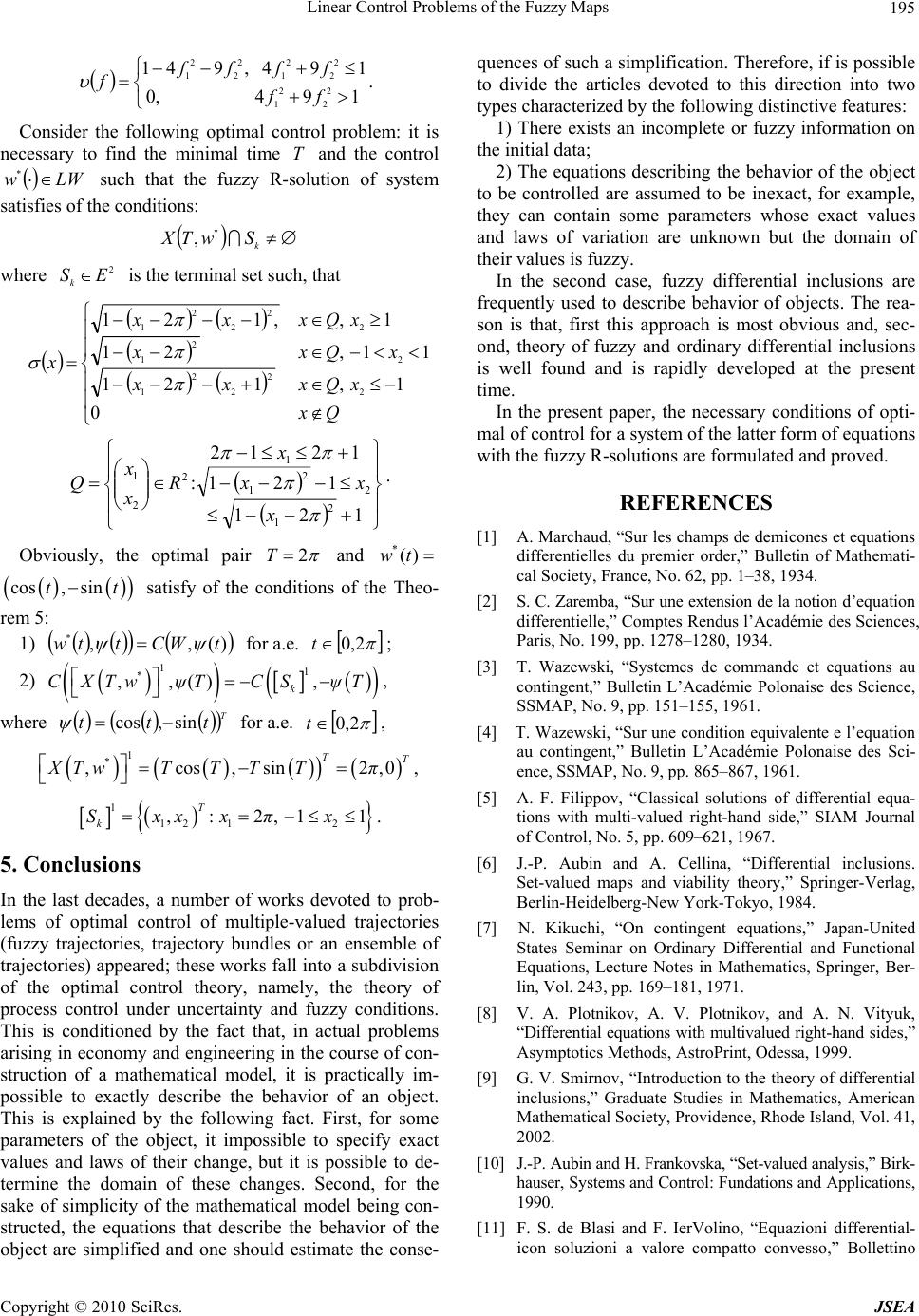 Linear Control Problems of the Fuzzy Maps195 194,0 194,941 2 2 2 1 2 2 2 1 2 2 2 1 ff ffff f . Consider the following optimal control problem: it is necessary to find the minimal time T and the control such that the fuzzy R-solution of system satisfies of the conditions: LWw * k SwTX * , where is the terminal set such, that 2 ESk Qx xQxxx xQxx xQxxx x 0 1,121 11,21 1,,121 2 2 2 2 1 2 2 1 2 2 2 2 1 121 121 1212 : 2 1 2 2 1 1 2 2 1 x xx x R x x Q. Obviously, the optimal pair 2T and *()wt satisfy of the conditions of the Theo- rem 5: cos,sint t 1) for a.e. )(,, *tWCttw 2,0t; 2) , 11 * ,,(), k CXTw ψTCSψT where for a.e. T ttt sin,cos 2,0t, 1 * ,cos,sin2, TT XTwTTTTπ 0, 1 12 12 ,: 2,11 T k Sxxxπx. 5. Conclusions In the last decades, a number of works devoted to prob- lems of optimal control of multiple-valued trajectories (fuzzy trajectories, trajectory bundles or an ensemble of trajectories) appeared; these works fall into a subdivision of the optimal control theory, namely, the theory of process control under uncertainty and fuzzy conditions. This is conditioned by the fact that, in actual problems arising in economy and engineering in the course of con- struction of a mathematical model, it is practically im- possible to exactly describe the behavior of an object. This is explained by the following fact. First, for some parameters of the object, it impossible to specify exact values and laws of their change, but it is possible to de- termine the domain of these changes. Second, for the sake of simplicity of the mathematical model being con- structed, the equations that describe the behavior of the object are simplified and one should estimate the conse- quences of such a simplification. Therefore, if is possible to divide the articles devoted to this direction into two types characterized by the following distinctive features: 1) There exists an incomplete or fuzzy information on the initial data; 2) The equations describing the behavior of the object to be controlled are assumed to be inexact, for example, they can contain some parameters whose exact values and laws of variation are unknown but the domain of their values is fuzzy. In the second case, fuzzy differential inclusions are frequently used to describe behavior of objects. The rea- son is that, first this approach is most obvious and, sec- ond, theory of fuzzy and ordinary differential inclusions is well found and is rapidly developed at the present time. In the present paper, the necessary conditions of opti- mal of control for a system of the latter form of equations with the fuzzy R-solutions are formulated and proved. REFERENCES [1] A. Marchaud, “Sur les champs de demicones et equations differentielles du premier order,” Bulletin of Mathemati- cal Society, France, No. 62, pp. 1–38, 1934. [2] S. C. Zaremba, “Sur une extension de la notion d’equation differentielle,” Comptes Rendus l’Académie des Sciences, Paris, No. 199, pp. 1278–1280, 1934. [3] T. Wazewski, “Systemes de commande et equations au contingent,” Bulletin L’Académie Polonaise des Science, SSMAP, No. 9, pp. 151–155, 1961. [4] T. Wazewski, “Sur une condition equivalente e l’equation au contingent,” Bulletin L’Académie Polonaise des Sci- ence, SSMAP, No. 9, pp. 865–867, 1961. [5] A. F. Filippov, “Classical solutions of differential equa- tions with multi-valued right-hand side,” SIAM Journal of Control, No. 5, pp. 609–621, 1967. [6] J.-P. Aubin and A. Cellina, “Differential inclusions. Set-valued maps and viability theory,” Springer-Verlag, Berlin-Heidelberg-New York-Tokyo, 1984. [7] N. Kikuchi, “On contingent equations,” Japan-United States Seminar on Ordinary Differential and Functional Equations, Lecture Notes in Mathematics, Springer, Ber- lin, Vol. 243, pp. 169–181, 1971. [8] V. A. Plotnikov, A. V. Plotnikov, and A. N. Vityuk, “Differential equations with multivalued right-hand sides,” Asymptotics Methods, AstroPrint, Odessa, 1999. [9] G. V. Smirnov, “Introduction to the theory of differential inclusions,” Graduate Studies in Mathematics, American Mathematical Society, Providence, Rhode Island, Vol. 41, 2002. [10] J.-P. Aubin and H. Frankovska, “Set-valued analysis,” Birk- hauser, Systems and Control: Fundations and Applications, 1990. [11] F. S. de Blasi and F. IerVolino, “Equazioni differential- icon soluzioni a valore compatto convesso,” Bollettino Copyright © 2010 SciRes. JSEA 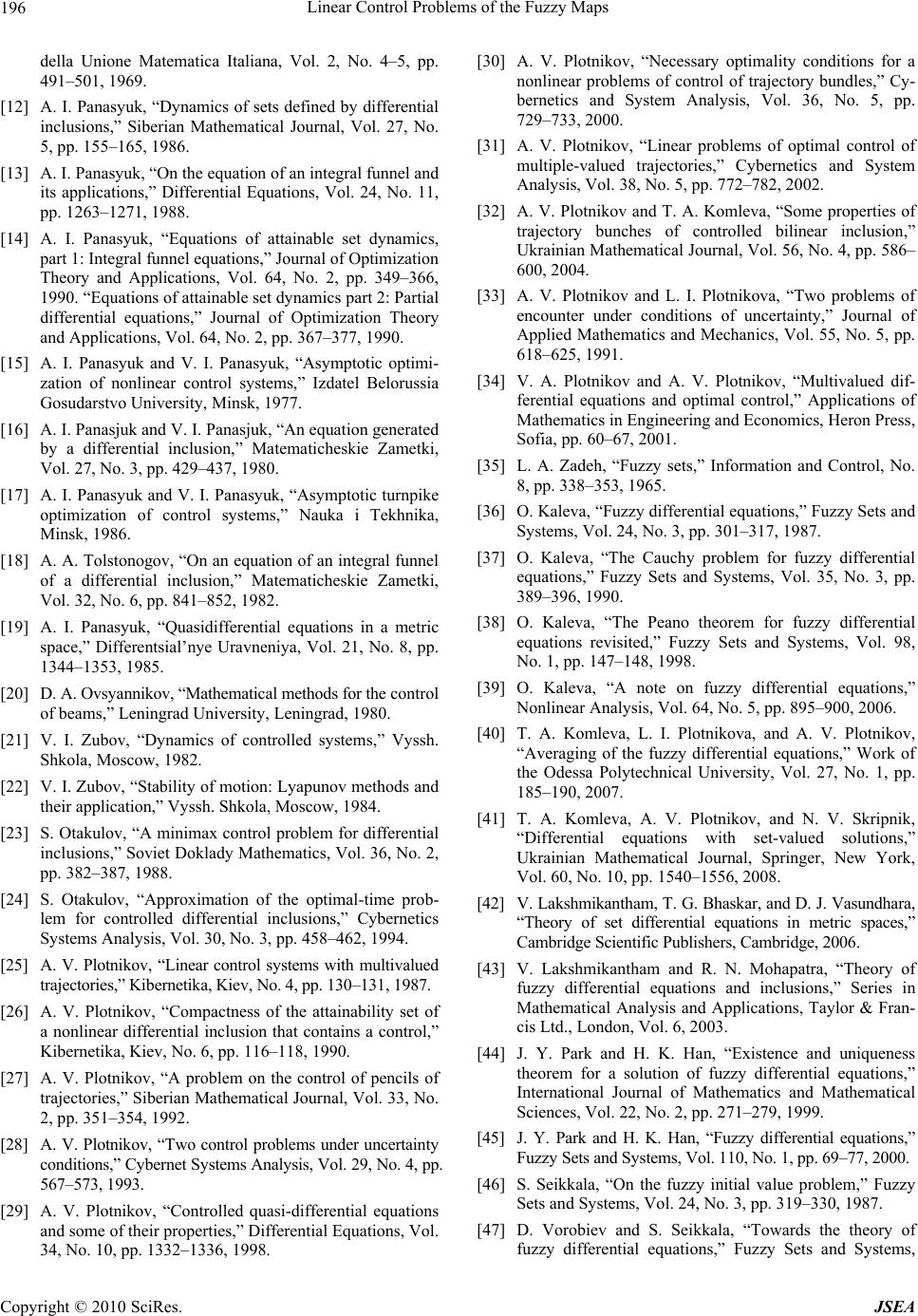 Linear Control Problems of the Fuzzy Maps 196 della Unione Matematica Italiana, Vol. 2, No. 4–5, pp. 491–501, 1969. [12] A. I. Panasyuk, “Dynamics of sets defined by differential inclusions,” Siberian Mathematical Journal, Vol. 27, No. 5, pp. 155–165, 1986. [13] A. I. Panasyuk, “On the equation of an integral funnel and its applications,” Differential Equations, Vol. 24, No. 11, pp. 1263–1271, 1988. [14] A. I. Panasyuk, “Equations of attainable set dynamics, part 1: Integral funnel equations,” Journal of Optimization Theory and Applications, Vol. 64, No. 2, pp. 349–366, 1990. “Equations of attainable set dynamics part 2: Partial differential equations,” Journal of Optimization Theory and Applications, Vol. 64, No. 2, pp. 367–377, 1990. [15] A. I. Panasyuk and V. I. Panasyuk, “Asymptotic optimi- zation of nonlinear control systems,” Izdatel Belorussia Gosudarstvo University, Minsk, 1977. [16] A. I. Panasjuk and V. I. Panasjuk, “An equation generated by a differential inclusion,” Matematicheskie Zametki, Vol. 27, No. 3, pp. 429–437, 1980. [17] A. I. Panasyuk and V. I. Panasyuk, “Asymptotic turnpike optimization of control systems,” Nauka i Tekhnika, Minsk, 1986. [18] A. A. Tolstonogov, “On an equation of an integral funnel of a differential inclusion,” Matematicheskie Zametki, Vol. 32, No. 6, pp. 841–852, 1982. [19] A. I. Panasyuk, “Quasidifferential equations in a metric space,” Differentsial’nye Uravneniya, Vol. 21, No. 8, pp. 1344–1353, 1985. [20] D. A. Ovsyannikov, “Mathematical methods for the control of beams,” Leningrad University, Leningrad, 1980. [21] V. I. Zubov, “Dynamics of controlled systems,” Vyssh. Shkola, Moscow, 1982. [22] V. I. Zubov, “Stability of motion: Lyapunov methods and their application,” Vyssh. Shkola, Moscow, 1984. [23] S. Otakulov, “A minimax control problem for differential inclusions,” Soviet Doklady Mathematics, Vol. 36, No. 2, pp. 382–387, 1988. [24] S. Otakulov, “Approximation of the optimal-time prob- lem for controlled differential inclusions,” Cybernetics Systems Analysis, Vol. 30, No. 3, pp. 458–462, 1994. [25] A. V. Plotnikov, “Linear control systems with multivalued trajectories,” Kibernetika, Kiev, No. 4, pp. 130–131, 1987. [26] A. V. Plotnikov, “Compactness of the attainability set of a nonlinear differential inclusion that contains a control,” Kibernetika, Kiev, No. 6, pp. 116–118, 1990. [27] A. V. Plotnikov, “A problem on the control of pencils of trajectories,” Siberian Mathematical Journal, Vol. 33, No. 2, pp. 351–354, 1992. [28] A. V. Plotnikov, “Two control problems under uncertainty conditions,” Cybernet Systems Analysis, Vol. 29, No. 4, pp. 567–573, 1993. [29] A. V. Plotnikov, “Controlled quasi-differential equations and some of their properties,” Differential Equations, Vol. 34, No. 10, pp. 1332–1336, 1998. [30] A. V. Plotnikov, “Necessary optimality conditions for a nonlinear problems of control of trajectory bundles,” Cy- bernetics and System Analysis, Vol. 36, No. 5, pp. 729–733, 2000. [31] A. V. Plotnikov, “Linear problems of optimal control of multiple-valued trajectories,” Cybernetics and System Analysis, Vol. 38, No. 5, pp. 772–782, 2002. [32] A. V. Plotnikov and T. A. Komleva, “Some properties of trajectory bunches of controlled bilinear inclusion,” Ukrainian Mathematical Journal, Vol. 56, No. 4, pp. 586– 600, 2004. [33] A. V. Plotnikov and L. I. Plotnikova, “Two problems of encounter under conditions of uncertainty,” Journal of Applied Mathematics and Mechanics, Vol. 55, No. 5, pp. 618–625, 1991. [34] V. A. Plotnikov and A. V. Plotnikov, “Multivalued dif- ferential equations and optimal control,” Applications of Mathematics in Engineering and Economics, Heron Press, Sofia, pp. 60–67, 2001. [35] L. A. Zadeh, “Fuzzy sets,” Information and Control, No. 8, pp. 338–353, 1965. [36] O. Kaleva, “Fuzzy differential equations,” Fuzzy Sets and Systems, Vol. 24, No. 3, pp. 301–317, 1987. [37] O. Kaleva, “The Cauchy problem for fuzzy differential equations,” Fuzzy Sets and Systems, Vol. 35, No. 3, pp. 389–396, 1990. [38] O. Kaleva, “The Peano theorem for fuzzy differential equations revisited,” Fuzzy Sets and Systems, Vol. 98, No. 1, pp. 147–148, 1998. [39] O. Kaleva, “A note on fuzzy differential equations,” Nonlinear Analysis, Vol. 64, No. 5, pp. 895–900, 2006. [40] T. A. Komleva, L. I. Plotnikova, and A. V. Plotnikov, “Averaging of the fuzzy differential equations,” Work of the Odessa Polytechnical University, Vol. 27, No. 1, pp. 185–190, 2007. [41] T. A. Komleva, A. V. Plotnikov, and N. V. Skripnik, “Differential equations with set-valued solutions,” Ukrainian Mathematical Journal, Springer, New York, Vol. 60, No. 10, pp. 1540–1556, 2008. [42] V. Lakshmikantham, T. G. Bhaskar, and D. J. Vasundhara, “Theory of set differential equations in metric spaces,” Cambridge Scientific Publishers, Cambridge, 2006. [43] V. Lakshmikantham and R. N. Mohapatra, “Theory of fuzzy differential equations and inclusions,” Series in Mathematical Analysis and Applications, Taylor & Fran- cis Ltd., London, Vol. 6, 2003. [44] J. Y. Park and H. K. Han, “Existence and uniqueness theorem for a solution of fuzzy differential equations,” International Journal of Mathematics and Mathematical Sciences, Vol. 22, No. 2, pp. 271–279, 1999. [45] J. Y. Park and H. K. Han, “Fuzzy differential equations,” Fuzzy Sets and Systems, Vol. 110, No. 1, pp. 69–77, 2000. [46] S. Seikkala, “On the fuzzy initial value problem,” Fuzzy Sets and Systems, Vol. 24, No. 3, pp. 319–330, 1987. [47] D. Vorobiev and S. Seikkala, “Towards the theory of fuzzy differential equations,” Fuzzy Sets and Systems, Copyright © 2010 SciRes. JSEA 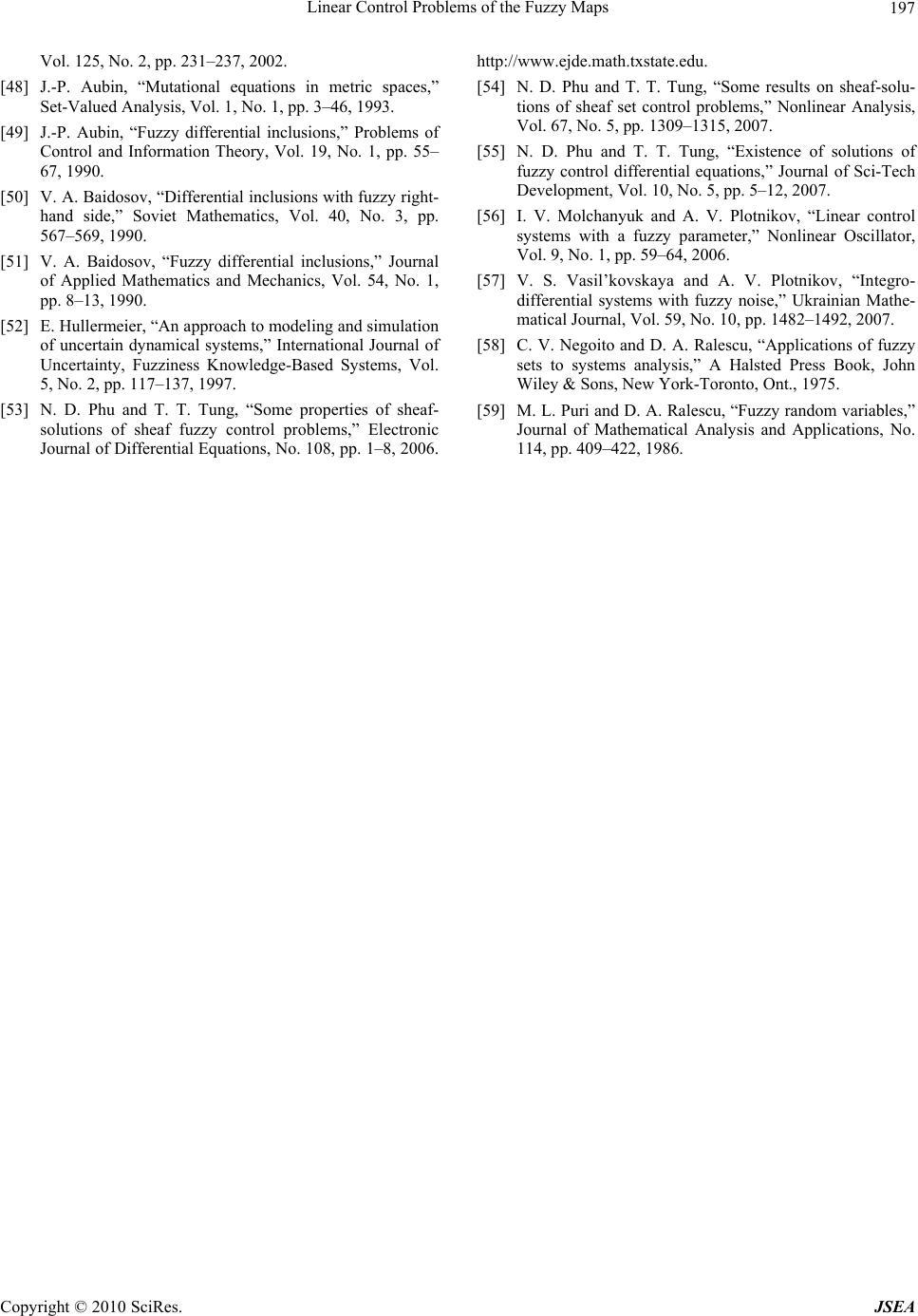 Linear Control Problems of the Fuzzy Maps Copyright © 2010 SciRes. JSEA 197 Vol. 125, No. 2, pp. 231–237, 2002. [48] J.-P. Aubin, “Mutational equations in metric spaces,” Set-Valued Analysis, Vol. 1, No. 1, pp. 3–46, 1993. [49] J.-P. Aubin, “Fuzzy differential inclusions,” Problems of Control and Information Theory, Vol. 19, No. 1, pp. 55– 67, 1990. [50] V. A. Baidosov, “Differential inclusions with fuzzy right- hand side,” Soviet Mathematics, Vol. 40, No. 3, pp. 567–569, 1990. [51] V. A. Baidosov, “Fuzzy differential inclusions,” Journal of Applied Mathematics and Mechanics, Vol. 54, No. 1, pp. 8–13, 1990. [52] E. Hullermeier, “An approach to modeling and simulation of uncertain dynamical systems,” International Journal of Uncertainty, Fuzziness Knowledge-Based Systems, Vol. 5, No. 2, pp. 117–137, 1997. [53] N. D. Phu and T. T. Tung, “Some properties of sheaf- solutions of sheaf fuzzy control problems,” Electronic Journal of Differential Equations, No. 108, pp. 1–8, 2006. http://www.ejde.math.txstate.edu. [54] N. D. Phu and T. T. Tung, “Some results on sheaf-solu- tions of sheaf set control problems,” Nonlinear Analysis, Vol. 67, No. 5, pp. 1309–1315, 2007. [55] N. D. Phu and T. T. Tung, “Existence of solutions of fuzzy control differential equations,” Journal of Sci-Tech Development, Vol. 10, No. 5, pp. 5–12, 2007. [56] I. V. Molchanyuk and A. V. Plotnikov, “Linear control systems with a fuzzy parameter,” Nonlinear Oscillator, Vol. 9, No. 1, pp. 59–64, 2006. [57] V. S. Vasil’kovskaya and A. V. Plotnikov, “Integro- differential systems with fuzzy noise,” Ukrainian Mathe- matical Journal, Vol. 59, No. 10, pp. 1482–1492, 2007. [58] C. V. Negoito and D. A. Ralescu, “Applications of fuzzy sets to systems analysis,” A Halsted Press Book, John Wiley & Sons, New York-Toronto, Ont., 1975. [59] M. L. Puri and D. A. Ralescu, “Fuzzy random variables,” Journal of Mathematical Analysis and Applications, No. 114, pp. 409–422, 1986. |

